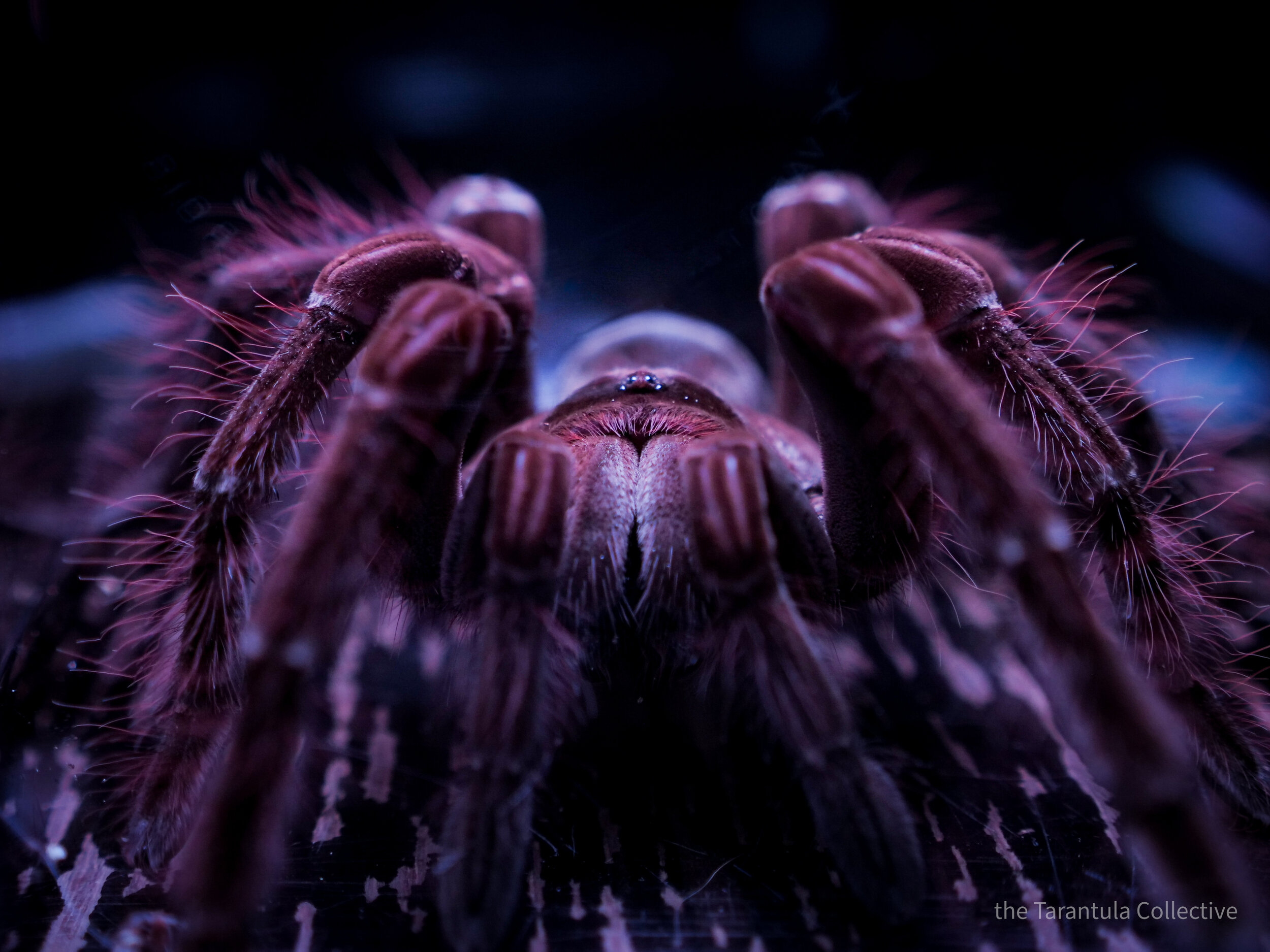Goliath Birdeater Tarantula (Theraphosa blondi/stirmi)
Care Sheet

Care & Husbandry Video
I show you how I care for my Theraphosa blondi (Goliath Birdeater), Theraphosa stirmi (Burgundy Goliath Birdeater), and Theraphosa apophysis (Pink Foot Goliath Birdeater). I break down what kind of enclosure I use, how often I feed, and what temperatures and humidity you need for these tarantulas.
Scientific Name: Theraphosa blondi
Common Name: Goliath Birdeater Tarantula
Type: Terrestrial Opportunistic Burrower
Category: New World
Endemic Location: North Brazil, French Guiana, Guiana, Suriname, South Venezuela
Body length: 4” (11cm)
Diagonal Leg Span (DLS): 11”(28cm)
Urticating Hairs: Yes, Type III
Growth Rate: Fast
Life Expectancy: Females 25 years / Males 5 years
Recommended Experience Level: Advanced
Theraphosa blondi, also known commonly as the Goliath Birdeater, was originally described by Pierre Andre Latrelle in 1804. There are two other closely related species to the blondi and they are the Theraphoa apophysis (pink foot goliath) and the Theraphosa stirmi (burgandy goliath birdeater). This is a very large New World terrestrial tarantula that comes from Brazil, Guyana and Venezuela. Of these 3 species of Theraphosa, the blondi is the most moisture dependent more so as an adult than as a spiderling. This Goliath bird eater is also one of the few tarantulas that can make an audible noise as they can hiss when they feel threatened, They produce this sound through stridulation, which is when they rub their legs together that have specialized hairs creating a hissing sound. The T blondi is widely said to be the largest spider in the world, when in fact that title probably belongs to the Heteropoda maxima (Giant Huntsman Spider) if you are going by the leg span. There is also the Pamphobetus antinous and Lasiodora parahybana that could also give the T. blondi a run for its money as far as being the largest tarantula, but there is no doubt that this is a large, thick and heavy tarantula that is undoubtedly an intimidating sight in person. Females of this species can reach a leg span of 10-11” with some people claiming that theirs have grown to as much as 12”. Usually their leg span is about the size of a dinner plate. Males are a little bit smaller with a leg span around 9 inches or so. Males typically only live about 5 or 6 years while the females can live over 20 years. This genus is also known for having extremely irritating urticating hairs that can lead to itching, burning, rashes, and even blisters if you were to come in contact with them. The side effects can be even worse if you were to get the hairs in your nose, mouth or eyes. The venom for this species is not considered medically significant, but due to the size of this tarantula, and its thick fangs, a bite would be quite painful regardless of its weak venom. Though they look somewhat similar there are some differences between the blondi, stirmi and the apophysis. The blondi has setae on the patella and the bottom side of the femura while the stirmi does not and the apophysis has much more setae which can be seen the most obviously on the bottom side of the legs. Also, the blondi has fangs and chelicerae (ka liss er ee) that are smaller than the stirmi and its carapace is also flatter. While the mature males of both the stirmi and blondi lack tibial hooks, the apophysis mature males have tibial hooks. The apophysis is also set apart by having more of a pinkish color hue and the spiderlings of this species are distinctly different as they have pinkish bands at the end of their legs. They also have lighter colored palps where as the stirmi and blondi spiderlings have much darker palps. These tarantulas are opportunistic burrowers, especially as spiderlings and juveniles which means you need to provide them with a hide and plenty of substrate for them to dig into.
I keep my spiderlings in a large acrylic terrestrial spiderling enclosure that is wider than my other spiderling enclosures. As the spiderlings of this species can be larger than those of most other species, and the fact that they put on a lot of size in between molts, their spiderling enclosure is nearly the size for what I use as a normal juvenile enclosure. This t is also very fast as slings and prone to quickly bolting and erratically running around the enclosure when disturbed, so i am sure to give them an enclosure that provides enough room to move around so they don’t dash out of their enclosure anytime I open the lid. I have not received a threat pose from a spiderling so far, but I cannot express enough how quickly they can bolt and it will undoubtedly catch you off guard every time if you are not prepared. I keep these species on coco fiber with vermiculite and sphagnum moss mixed in to help with drainage and maintain humidity. I pour water down the corners of the enclosure to soak the bottom layer of substrate and let it start to dry out before re-soaking while always keeping the water dish full. I also place some sphagnum moss in the enclosure that i regularly wet about once a week to also help maintain a higher humidity level. Any enclosure i use for this species I opt for cross ventilation holes as opposed to ventilation holes on the top of the enclosure. This aids in keeping a little more humidity in while providing beneficial cross ventilation. Once this T molts and begins to enter a juvenile stage, I move them into a bio-active juvenile enclosure. For this type of enclosure i take a display case for something like a football and put ventilation holes on two sides of the enclosure. I put a small layer of clay balls or pea gravel on the bottom, I then add a layer of mesh and top it off with a bioactive substrate that you can purchase from businesses like josh’s frogs or bio dude. If I don’t have any of that readily available, I use a 50/50 mixture of coco fiber and peat moss and then add in some vermiculite and sphagnum moss. When I make the substrate myself, I also mix in some bio booster powder, though that isn’t necessarily required. I wet the entire substrate until water begins to drain down to the bottom layer. I provide a hide and large water dish and add a few plants that don’t require extremely bright light. Having plants really makes the enclosure look nice, but also contributes to the humidity of the enclosure. I add springtails and sometimes some blue dwarf isopods to help keep the enclosure clean. This T is still very bolty at this size, so when it looks like it starting to outgrow this enclosure, i move into a larger acrylic enclosure set up nearly identically. This type of enclosure I also make myself from clear acrylic shoe boxes for boots that i have on the enclosure and husbandry list in my amazon store which is linked below in the description for this video. I put cross ventilation holes on the sides of the enclosure, start with a layer of clay balls, then mesh, and then the same substrate as the previous enclosure. I also add plants, large water dish and a hide. The larger this species gets, especially the T. blondi, the more diligent I am to make sure to not let the enclosure dry out and keep the humidity up. Once this tarantula really starts to put on size, I set up its final adult enclosure. I have yet to find an acrylic enclosure large enough and sturdy enough to house an adult T that is not extremely expensive, though I am sure they exist if you are willing to shell out the money. A lot of people use 15-20 gallon glass aquariums, but personally I am using an Exo Terra medium low enclosure with some modification. This tarantula can climb the glass walls of the enclosure, despite its size, and can be quite strong and will easily push off any lid that isn’t securely locked down. It also has very large and powerful fangs that can chew through nearly any mesh lid. I prefer the exo terra because it does provide some cross ventilation in its design with an opening in the front below the doors and has a locking lid at four points. The mesh screen of this enclosure is not ideal and must be removed and replaced with acrylic sheets securely siliconed into place. I start again with a drainage level of clay balls or small gravel, followed by a layer of mesh, then add the bioactive substrate from before. I provide a large water dish, a large hide, and plenty of substrate for the t to burrow in, though at this size they tend to spend a lot of time out in the open. I add some spring tails to keep things clean and healthy and add a few plants. I also put plenty of sphagnum moss in a few different places in the enclosure and wet them down once a week to keep the humidity up.
As far as feeding, I feed my spiderling 1-2 small crickets twice a week and remove any uneaten prey within 24 hours. I wait about 4-5 days after a molt before attempting to feed again. It is important to give the freshly molted tarantula enough time to harden up after a molt. For juveniles I feed 3-4 medium crickets every 7-10 days depending on the size of the abdomen. I will feed more often for a while after a molt, but as the abdomen begins to get larger, i cut back to every 2-3 weeks until the t enters premolt. And once they are adults, i feed them 3 or 4 large dubia roaches every other week or about a dozen crickets every 2-3 weeks. I also mix up their diet with large superworms, green horn worms, red runners, or any other large invertebrate feeder i have available. Despite their name, this tarantula does not actually eat birds and even feeding them a live mouse can be dangerous if the mouse were to bite the tarantula during the struggle. There are plenty of videos online of people feeding the goliath birdeaters live mice and they get a lot of views and are very dramatic to watch, but personally I don’t want to risk the health of my specimens and risk a live mouse could biting off a leg, or even worse, rupturing the T’s abdomen in the struggle...and I dont personally want to risk my tarantulas health and well being for the sake of making a exciting video. A possible alternative would be to feed your theraphosa adult a feeder lizard like an anole once or twice a year… It is very important that whatever you choose to feed your goliath birdeater, you clean up after them. You need to remove any uneaten prey, boluses, or molts as soon as possible as the humidity in their enclosures are higher than most other enclosures and these things can quickly mold and attract unwanted guests like mites or even ants. So spot cleaning is important, especially after feeding.








